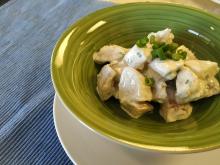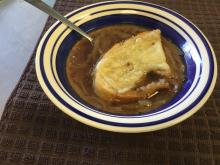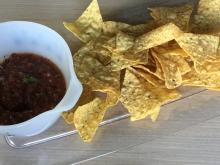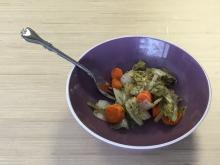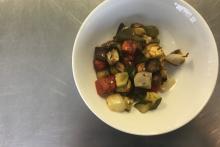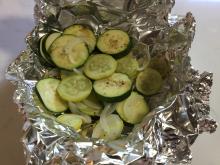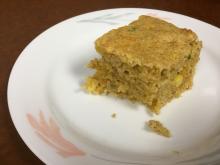
Onions can serve as the star in a recipe like onion soup or play a supporting role. For today's post, I'll talk about more common bulb and spring onions, and others in the allium genus, including leeks, shallots, and chives.
Nutritionally, a single medium raw bulb onion contains around 60 calories, 14g carbohydrates, 3g fiber, and is a source of vitamins and minerals including folate, vitamin C, potassium, and phosphorus. Like many non-starchy veggies, onions are not a significant source of fat, protein, or sodium.
- Availability: Bulb and green onions and shallots are common in stores. Leeks and chives may be specialty items available at larger stores, through local farmers, or by growing your own.
- Buy:
- Fresh: In general, no matter what type of onion or other allium, good quality veggies will be firm, have deep colors typical for the variety, and do not have soft, slimy, or discolored spots.
- Packaged: For convenience, bulb onions, and sometimes green onions, may be pre-chopped and sold in your store's produce section. Examine the "use-by" or "sell-by" date on the package to check if the product might need to be used soon.
- Frozen: Bulb onions may be available pre-chopped in the freezer section of your stores. These are a simple convenience item.
- Dried: This could include freeze-dried or traditionally dehydrated onion in minced, flaked, or powdered (granulated) form. Check that you are buying the variety you want. Onion salt will have sodium.
- Price: Fresh onions average $1.05 per pound, according to USDA Fruit and Vegetable Prices.
- Store:
- Follow Package Info: For pre-chopped onions, frozen, dried, and other forms, follow storage guidelines on the package.
- Room Temperature: Fresh bulb onions and shallots store well at room temperature. Once cut, refrigerate extras.
- Refrigerator: Leeks, green onions, and chives do better stored in the refrigerator. I like to put green onions in a glass with water just covering the white bulb and covering with a zip-top bag, refrigerate, and change the water every few days to help keep them crisp, sometimes up to two weeks. See photo for example.
- Prepare:
- Wash: Onions and other alliums are grown in close contact to soil and it is important to wash before using. Leeks in particular can have soil between its many layers.
- Cut: Sometimes it helps to watch preparation skills, so enjoy watching these how-to videos on cutting onions, green onions, and leeks.
- Preserve: The National Center for Home Food Preservation has directions on freezing, pickling, and drying onions and green onions. Herbs, including chives, freeze well. However, leeks do not preserve well.
- Substitutes: For some people, onions and other alliums are not flavors they enjoy, or because of restrictions during a FODMAP phase. To still get onion flavors, consider cooking with onion-infused or shallot infused oils, or using tops of green onions or chives for a lighter flavor.
- Eat: So, this may be what brought you to this blog post. While there are recommendations on what type of onions and alliums to use raw or cooked, with certain foods, etc., cooking is also an art. Feel free to explore and try onions and alliums in ways that make sense to you! And, as always, try out a recipe below.
Recipes
Garlic and Chive Potato Salad | Print recipe
Onion Soup | Print recipe
Blender Salsa | Print recipe
Braised Napa Cabbage with Carrots and Leek | Print recipe | Watch video
Roasted Ratatouille | Print recipe | Watch video
Summer Squash and Onion Packets | Print recipe | Watch video
Chive Cornbread | Print recipe
References:
-
Utah State University, Food Sense, Onions, N/D
-
Michigan State University Extension, Michigan Fresh, Leeks, 2013
-
South Dakota State Extension Extension, Leeks, 2020
-
US Department of Agriculture, Agriculture Research Service, National Nutrient Database for Standard Reference
Post originally published in 2015; content updated in 2021.
Healthy Eats and Repeat
How much difference is there between canned and frozen foods? How should you cook venison? When is the best time to buy avocados? Get answers to these questions as well as other tips, tutorials and recipes for common kitchen foods and items with University of Illinois Extension Nutrition & Wellness Educator Caitlin Mellendorf. Build your best life. Trust Extension to help.
Caitlin Mellendorf is an Illinois Extension Nutrition and Wellness Educator serving DeWitt, Macon and Piatt Counties in Central Illinois. She is a Registered Dietitian and her work focuses on helping community members gain the knowledge, skills and tools to live healthier, more nutritious lifestyles. This includes providing programs and answering questions about heart health, diabetes, food safety, food preservation, grocery shopping and cooking. You can reach Caitlin by email at chuth2@illinois.edu or call 217.877.6042.

